Transpiration - thinking scientifically
Transpiration is the evaporation of water from plant surfaces, predominantly, through tiny holes on the surface of leaves called stomata.
We can measure the rate of transpiration, using the method outlined below.
Equipment
Olive oil.
50 mL measuring cylinder.
A tree cutting.
A fan or heater.
Graph paper.
Pen
Microscope ( X400)
Slide
Clear sticky tape.
Scissors
Portable fan heater
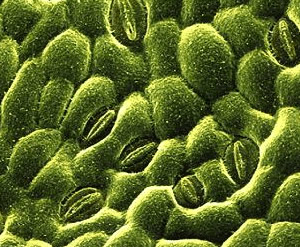
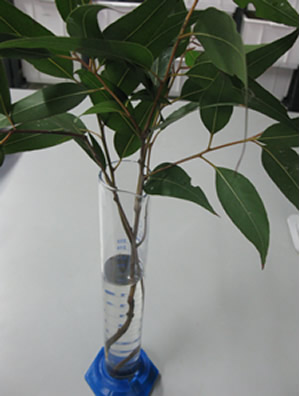
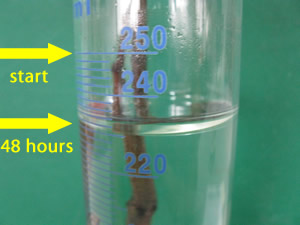
Click to see a larger image of the picture on the right.
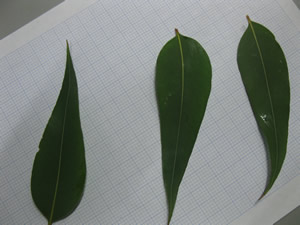
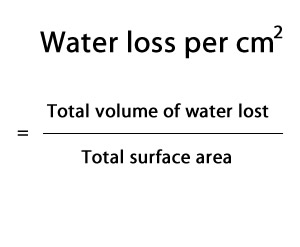
Step 5 Measure the density of stomata per square centimetre of leaf area on the top and on the bottom. Take a leaf and using a ball point pen cover a small section of leaf with ink, as shown on the right.
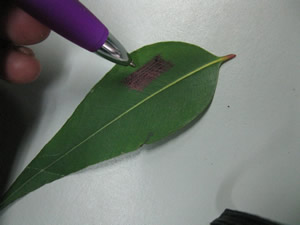
Step 6 Press a piece of clear sticky tape on to the ink and press firmly with you finger. Pull the tape off and place it on a microscope slide.
Click to see an alternative way of counting stomata using nail polish.

Step 7 View the ink pattern under the microscope. A magnification of X400 is best to pick up the stomata, as shown on the right. Only some of the stomata are shown with the yellow arrow.
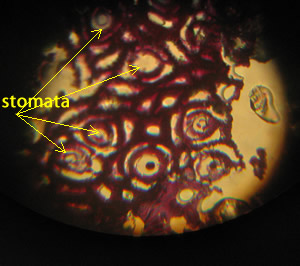
At a magnification of X100 the diameter of the field of view is 1.50 mm but under X400 magnification the diameter of the field of view is diminished to 0.375 mm.
What is the total area of the field of view at X400 magnification in mm2?
A students set out to measure the density of stomata on the top and bottom surfaces of a eucalptus leaf.
Click to see the top. The pointer points to a stoma.
Click to see the bottom.
Calculate the density of stomata per cm2 of leaf area for both the top and the bottom surfaces.
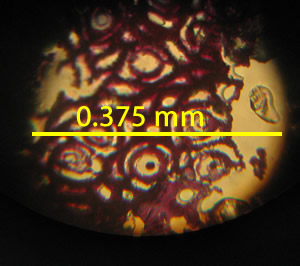
1) Is there a difference in the density of stomata when comparing the top and the bottom surface? If so what is the difference?
2) Eucalyptus trees are adapted to dry, hot conditions. Why do you think that eucalyptus trees have a greater density of stomata on the top surface than on the bottom surface?
3) Outline investigations to determine the impact on transpiration of:
- temperature,
- wind.
i) State the dependent and independent variables.
4) A student was asked to conduct an investigation to determine the rate of transpiration of a leafy, flowering desert plant. She used the same setup as the one shown on the right and discussed above.
The student thought that with an increase in temperature would come an increase in water loss through transpiration. Her results are shown in table form below.

i) What is the best way to represent the data shown on the left of a desert, flowering plant.
ii)
Graph the results shown on the right on an appropriate set of axis.
ii) What was the student's hypothesis?
iii) What do the results suggest?
iv) Was the student's hypothesis supported by the results? Explain.
v) What changed every time the student did a new test?
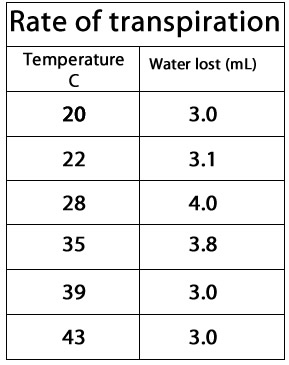
5) Describe an experimental technique required to test for a difference in rates of transpiration between rainforest eucalyptus trees compared to desert eucalyptus trees.
i) What are the dependent and independent variables in this investgation.
ii) What factors will stay the same in each test?
- Leaf surface area of each type of eucalypt.
- Length of cutting.
- Temperature
- Type of water used.
- Volume of water used
- Amount of sunlight
- The length of time the test is conducted for.
iii) What is a possible hypothesis
?
Extension activity.
A) Devise a method to workout the total leaf surface area of a tree and calculate the average volume of water, in litres, that will transpire per day. Outline in detail your procedure.